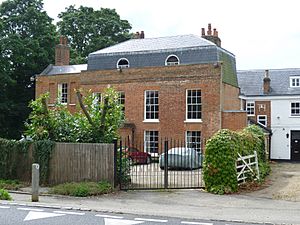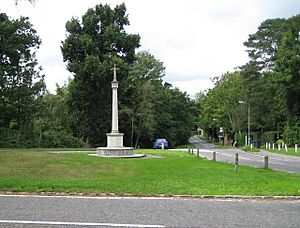Totteridge facts for kids
Quick facts for kids Totteridge |
|
|---|---|
 |
|
| Population | 15,159 (2011 Census. Ward) |
| OS grid reference | TQ245945 |
| London borough | |
| Ceremonial county | Greater London |
| Region | |
| Country | England |
| Sovereign state | United Kingdom |
| Post town | LONDON |
| Postcode district | N20 |
| Dialling code | 020 |
| Police | Metropolitan |
| Fire | London |
| Ambulance | London |
| EU Parliament | London |
| UK Parliament |
|
| London Assembly |
|
Totteridge is a lovely area in London, England. It's part of the London Borough of Barnet. You'll find a mix of homes and green spaces here, including some farms. It's about 8 miles (13 km) north-west of central London. It also shares the N20 postal code with Whetstone.
Totteridge is also the name of a local area (called a 'ward') within the borough. It's home to the St Andrew's Church parish, which is part of the Diocese of St Albans.
Contents
A Look Back: Totteridge's History
Totteridge has a long history! In the 13th century, it was known as 'Tataridge'. This name might have come from someone called Tata. The "ridge" part refers to the high ground between two streams, the Dollis Brook and Folly Brook.
Over many centuries, Totteridge's beautiful countryside attracted wealthy families. For example, Cardinal Manning was born here in 1808 at a place called Copped Hall.
How Totteridge Grew Over Time
When the Great Northern Railway station opened in 1872, more people started to move here. Big houses were built around the old village during the late Victorian and Edwardian times.
Later, in the 1930s, the railway station became a London Underground station (part of the Northern line). This made it even easier to get to Totteridge. Smaller homes were then built closer to the station (Totteridge and Whetstone tube station).
To protect its special feel, much of Totteridge was made a "Conservation Area" in 1968. This means that big new buildings are not allowed, helping to keep the area looking much as it always has.
Totteridge's Changing Borders
Totteridge used to be a civil parish in Hertfordshire. A civil parish is a local area with its own council. It covered about 1,604 acres (6.5 square kilometers).
From 1894 to 1914, Totteridge had its own parish council. Then, it became part of the Barnet Urban District until 1965. In 1965, a new law changed the map of London. Totteridge moved from Hertfordshire to Greater London and became part of the London Borough of Barnet.
Exploring Totteridge: Geography and Landmarks
Totteridge is surrounded by natural beauty. The Dollis Brook forms its northern and eastern border. To the south, you'll find the Folly Brook, which flows into the Dollis Brook. These streams help define the area.
Main Roads and Historic Buildings
The main road through Totteridge is the A5109. It changes names as it goes along:
- Totteridge Common (western part)
- Totteridge Village
- Totteridge Green (near the village green)
- Totteridge Lane (eastern part, leading into Whetstone)
St. Andrew's Church is a very old and important building. A chapel has been on this site since at least 1250! The churchyard's round shape suggests it was an ancient meeting place.
Inside the churchyard, there's an amazing yew tree. Experts from Kew Gardens believe it's about 2,000 years old, making it the oldest tree in London!
Other historic buildings include:
- The Tithe Barn and the animal pound: These date back to the 16th and 17th centuries. They are now part of Pound House.
- West End House barn and Laurel Farm barn: Built in the 17th century, these are now private homes.
- Willow House and Rose Cottage: These are timber-framed buildings from the Tudor era.
Sadly, some important old houses like Copped Hall and Poynters Hall were knocked down between the two World Wars.
Homes and Famous Residents
Totteridge is known for its large, beautiful homes surrounded by greenery. Many of these houses are among the most expensive in London. Because of this, many famous people have lived here, including:
- Arsène Wenger (former Arsenal FC manager)
- Frankie Vaughan (singer)
- Des O'Connor (entertainer)
- Cliff Richard (singer)
- Bruce Forsyth (TV presenter)
- David Ginola (former footballer)
There are also more modest homes, especially towards the eastern end of Totteridge.
 |
Arkley | Chipping Barnet | High Barnet |  |
| Barnet Gate | Whetstone | |||
| Edgware | Mill Hill | Woodside Park |
Getting Around: Transport in Totteridge
Totteridge has good transport links, making it easy to travel around London and beyond.
Bus Routes
- Route 251: This bus travels through Totteridge Village along the A5109. You can take it towards Edgware or Arnos Grove tube stations.
- Route 326: This bus runs along the eastern part of Totteridge Lane. It goes towards Barnet or Brent Cross Shopping Centre.
Tube Stations
The closest underground station is Totteridge and Whetstone tube station on the Northern line. Both the 251 and 326 bus routes stop right outside the station. Woodside Park tube station is also nearby, at the southern edge of the area.
Railway Station
- Oakleigh Park: This railway station is served by Govia Thameslink Railway. You can catch the 383 bus to get there.
Who Lives Here: Totteridge's Population
Totteridge is a diverse place with people from many different backgrounds.
Population Facts (2011 Census)
- The population of Totteridge ward was 15,159 people.
- About 66% of the people were white (including British and other European backgrounds).
- Around 10% were Indian, and 8% were from other Asian backgrounds.
- About 40% of the people were Christian.
- 17% said they had no religion.
- 16% of the population was Jewish.
Fun and Games: Sport and Leisure
Totteridge has a lively sports community, especially for cricket!
Totteridge Millhillians Cricket Club
This cricket club is a big part of the local community. It was formed when Totteridge Cricket Club and Old Millhillians Cricket Club joined together. The club is located just off Totteridge Green.
They have several teams that play in the Saracens Hertfordshire Cricket League. They also have a Ladies team, a Sunday team, and a special section for younger players called the Colts. The Colts include teams like the U15 Tornadoes, U13 Warriors, and U11 Sharks.
Green Spaces: Nature Reserves
Totteridge is home to several important nature spots, known as Sites of Importance for Nature Conservation. These places help protect local wildlife and plants.
Some of these beautiful nature reserves include:
- Darland's Lake Nature Reserve
- Totteridge Green
- Totteridge Common
- Totteridge Fields
- Dollis Brook
- Folly Brook
- Totteridge Croft Field (or Dell's Down Acre)
Notable Residents
Many interesting people have called Totteridge home:
- Mike Ashley, a well-known businessman.
- David Dein, former Vice-Chairman of Arsenal FC and a Premier League Ambassador.
- Edward Bulwer-Lytton, a famous novelist and politician.
- Peter Meyer, a merchant.
- Arsène Wenger, the highly respected former manager of Arsenal FC.
- Fiammetta Wilson, an astronomer.





